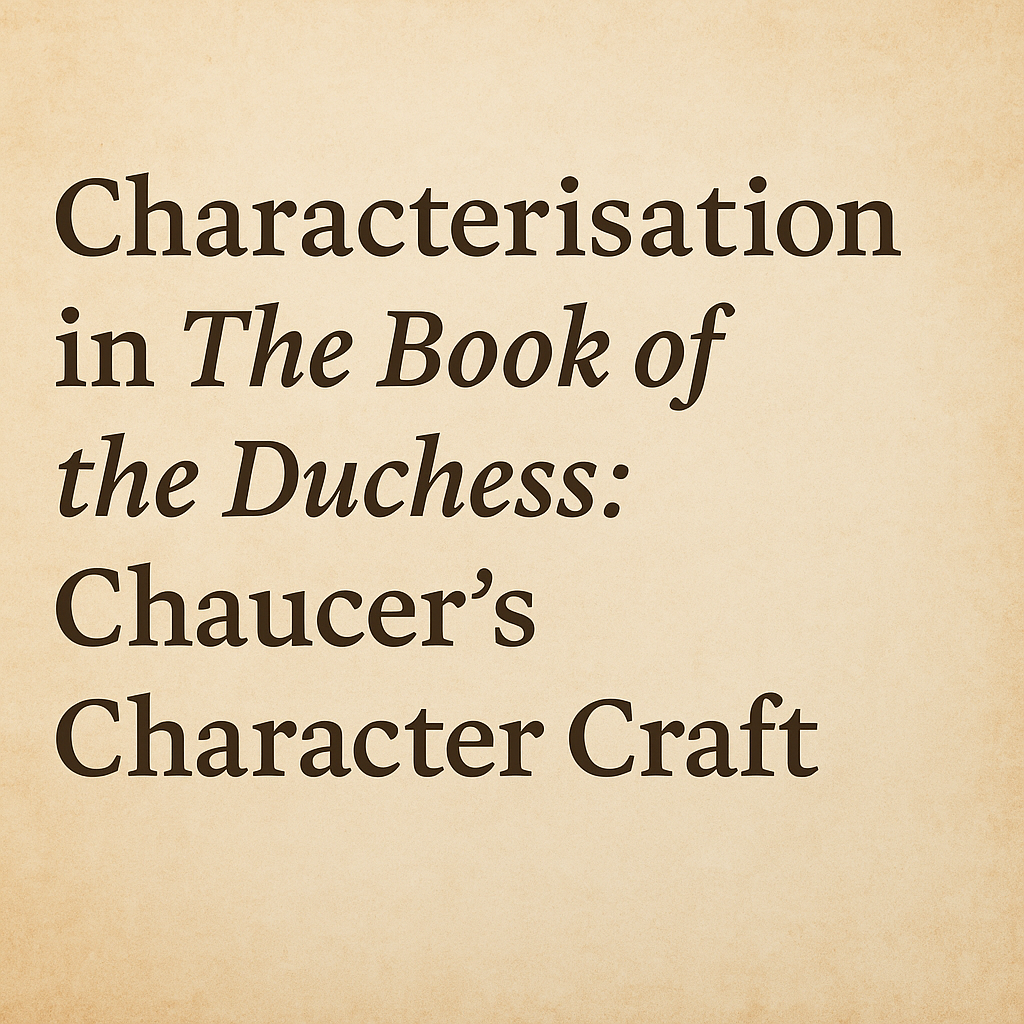Introduction
Understanding characterization in The Book of the Duchess is essential for grasping Chaucer’s unique narrative style. This dream-vision poem, written in the late 14th century, offers rich layers of emotional depth through its portrayal of characters, especially the narrator and the Black Knight. Because of the poetic form and narrative structure, characterization in The Book of the Duchess holds a central place in literary discussions. This article explores how Chaucer develops his characters, focusing on the techniques and symbolic roles they serve in the narrative.

Importance of Characterisation in The Book of the Duchess
One of the most notable strengths of Chaucer’s writing lies in his ability to develop character personalities with psychological realism. Characterisation in The Book of the Duchess does not rely on elaborate plot twists. Instead, it focuses on inner emotions, dialogue, and symbolic representation to express themes of love and grief.
The characters are not just tools to move the story forward. Rather, they represent ideas, moods, and moral states. The use of dream vision allows Chaucer to present characters in a stylized, yet emotionally resonant form. Therefore, characterization in The Book of the Duchess becomes the backbone of the entire poetic narrative.
The Narrator’s Role in Characterization
H3: Characterization Through the Dreamer’s Perspective
The poem begins with a sleepless narrator, who becomes the dreamer. His insomnia, frustration, and eventual vision reflect deep psychological states. This subjective entry into the narrative immediately shapes characterization in The Book of the Duchess. The narrator is not a distant observer. Instead, he is a sensitive, confused, and curious participant.
Moreover, the narrator’s lack of understanding and need for clarity mirrors the reader’s experience. Through this lens, characterization in The Book of the Duchess becomes more engaging. The narrator asks questions, makes interpretations, and even misreads situations, making the unfolding of other characters more dynamic.
Characterization of the Black Knight
Emotional Depth and Grief
The most compelling example of characterization in The Book of the Duchess is the Black Knight. He represents mourning, love, and loyalty. When he is first introduced, he is found lamenting in a forest, an image that sets the tone for his sorrowful tale.
His use of metaphor and symbolic language to describe his lady—Blanche—adds emotional complexity. He speaks of her in glowing terms, presenting her as both a real woman and an ideal. This duality enriches characterisation in The Book of the Duchess by blending realism with allegory.
H3: Dialogue and Self-Revelation
The Knight’s dialogue with the narrator forms the central part of the poem. His responses are often poetic and filled with layered meanings. Importantly, his grief is not described by the narrator but shown through his own words. This technique makes characterisation in The Book of the Duchess more immediate and authentic.
The gradual unfolding of his story, especially his indirect reference to Blanche’s death, reflects how humans process loss. This subtlety adds to the emotional realism of the character.
Lady Blanche as an Idealized Figure
Blanche does not appear in the dream directly, but she dominates the Knight’s thoughts. Therefore, her character is constructed through his memories. Characterisation in The Book of the Duchess uses this indirect method to present Blanche as both a personal loss and a universal symbol of feminine beauty and virtue.
Her character illustrates medieval ideals—she is pure, loyal, kind, and beautiful. This technique of character construction allows Chaucer to explore not only individual grief but also cultural standards of womanhood. Thus, characterization in The Book of the Duchess extends beyond the individual to touch broader social ideas.
Supporting Figures and Symbolic Characters
Though the narrator and the Black Knight are the main focus, characterisation in The Book of the Duchess includes other symbolic figures. For example, Morpheus, the god of sleep, and other mythological references contribute to the dreamlike tone and help convey psychological states. These figures do not have deep personalities, but their presence helps to create a structured symbolic world that enhances the emotional experience.
Even animals and the natural surroundings subtly reflect the emotions of the central characters. This environment-driven characterization is a hallmark of Chaucer’s style.
Poetic Techniques Supporting Characterisation
Use of Imagery and Symbolism
Imagery plays a strong role in characterization in The Book of the Duchess. The Black Knight’s metaphors, such as describing Blanche as the sun, elevate her to a divine level. These symbols not only enrich character presentation but also invite readers to interpret emotional states.
Rhyme and Rhythm in Dialogue
Chaucer’s use of rhyme and meter ensures that the characters’ voices remain lyrical. This musicality adds beauty to the text and deepens the emotional resonance. It’s another technique that boosts the quality of characterization in The Book of the Duchess.
Psychological Realism and Modern Appeal
Though written in the 14th century, the poem’s emotional core feels modern. Grief, confusion, and love are all timeless themes. Chaucer’s technique of showing rather than telling brings psychological depth to his characters. Therefore, characterization in The Book of the Duchess remains a powerful tool for understanding human emotion across eras.
Conclusion
In conclusion, characterization in The Book of the Duchess is both subtle and powerful. Through symbolic dreams, lyrical dialogue, and emotional expression, Chaucer crafts characters that feel deeply human. The narrator’s curiosity, the Knight’s sorrow, and Blanche’s idealization all contribute to a rich literary experience. Moreover, the poetic techniques and symbolic layers add depth to every character. Anyone exploring Chaucer’s early work should pay close attention to the way characterization unfolds, as it is the emotional engine that drives this moving poem forward.
English Literature: https://englishlitnotes.com/category/history-of-english-literature/
Notes on English for All Classes: https://englishwithnaeemullahbutt.com/
Discover more from Naeem Ullah Butt - Mr.Blogger
Subscribe to get the latest posts sent to your email.
